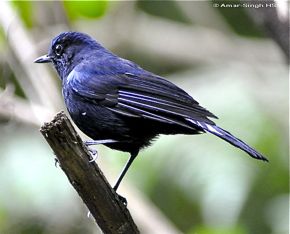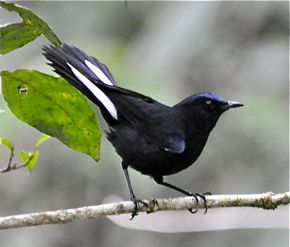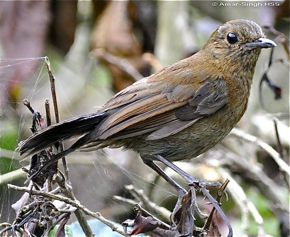“[The White-tailed Robin (Myiomela leucura leucura)] is not an easy bird to watch and very hard to get good pictures. Have seen them at many locations at this particular highlands (Camerons) but they are best seen on the narrow road that leads up Brinchang Mountain. They have taken a liking to forage on and by the side of the road, and any keen observer can spot them there. They prefer living near a stream. They are usually solitary or in pairs. I have only once seen it as part of a bird wave in May 1993.
“It is a very shy bird and will disappear into the primary forest by the side of the road the moment you approach 10-12 meters. In addition much of the road has primary forest on both sides and is rather dark for non-flash photography. They are best photographed from the car which they seem to tolerate. However the problem of stopping to take pictures is the tourist traffic going up and down this single lane road (all rushing to the tower at the top). The other way is to abandon the tripod and flash (both of which frighten most birds) and wait patiently by the side of the road to be rewarded by reasonable views.
“We usually see 3-4 pairs on any trip up this mountain and have got a clear idea on which stretches of the narrow road they will be at. This trip the numbers were very encouraging. They appear to have been breeding well at this location and from 1,600m to 1,800m along this road we spotted two breeding pairs (one with two juveniles), three other single adult males, two other single females (one subadult) – 11 White-tailed Robins on 3 km of mountain road.
“What surprised me was that two of the females were spotted at the tea garden (lower stretches of the road). Morten Strange (Photographic guide to Birds of Malaysia & Singapore, 2000) states that they come lower during the ‘winter months’. However in all my visits there have not seen them this low.
“G C Madoc (An Introduction to Malayan Birds, 1956), one of our best bird watchers for behaviour and description, states ‘the species appears to be silent, and I have never heard it sing’. I generally agree with him but, as this was breeding season, the air was full with song by the male (and possibly female from the shadows). Have some ‘shaky’ handheld videos of the male singing delightfully. Loves to stand on a low branch and sing for considerable periods if not disturbed. Some of the juveniles were also calling out for food. Suspect the song was primarily territorial by the male (due to breeding) but also a few appeared to be warning whistles due to our presence.
“The male can look very dark unless the light is shining on it, then it is seen to be a delightful blue with lighter patches at the shoulder and forehead and white in the tail. They forage extensively by the roadside and like to hop about, occasionally fanning their tail and showing the distinctive white on the tail feathers in both sexes. The females are brown with the same white in the tail. They also do the tail fanning behaviour.
“One was seen bringing an earthworm to the nest while a juvenile in the shadows was still being fed.”
Dato’ Dr Amar-Singh HSS
Gunung Brinchang (1,600-1,800m ASL)
Cameron Highlands, Malaysia
14th May 2010
Images of male (top two) and subadult female (bottom) by Dato’ Dr Amar-Singh HSS.











